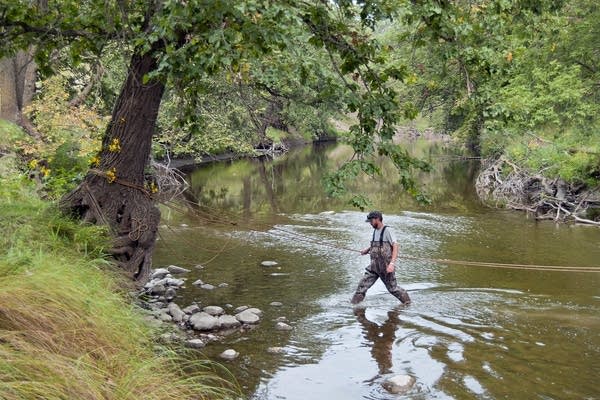Turkey farmers brace for possible return of bird flu

Go Deeper.
Create an account or log in to save stories.
Like this?
Thanks for liking this story! We have added it to a list of your favorite stories.
Minnesota poultry farms are concerned the arrival of the fall waterfowl migration could bring with it the return of avian flu.
The disease clobbered the state's turkey and chicken industries last spring with over $600 million in losses, but researchers still don't have a solid answer for how the virus spread to more than 100 farms in Minnesota.
There's a consensus that migrating ducks and geese carried bird flu into the state. However, thousands of waterfowl droppings have been tested for the virus and there hasn't been a single positive result.
Undaunted, Minnesota Department of Natural Resources employees are still sloshing through the state's lakes and sloughs, hoping to pick up the trail of the virus from animals caught in live traps and tested.
Turn Up Your Support
MPR News helps you turn down the noise and build shared understanding. Turn up your support for this public resource and keep trusted journalism accessible to all.
So far, none of the birds trapped have been found to be carriers of the virus.
"Whether the virus will come back or not is unpredictable," said state veterinarian Dr. Bill Hartmann.

Central Minnesota turkey grower Greg Langmo says he lost at least $100,000 last spring when bird flu struck two of his five turkey farms. But he's since restocked turkeys in all his barns and things are looking up.
"Oh they're doing great," said Langmo. "It's been a great year to raise turkeys. Temperatures haven't been real warm, humidity's been reasonable."
But Langmo says he's worried about getting hammered again this fall. The main thing he and other Minnesota poultry producers are doing is to strengthen biosecurity measures.
Langmo hopes to build a mostly invisible shield around his barns that the virus cannot penetrate. One of the most popular steps is to install what's known as a 'Danish entry' system.
"The basic premise is to keep what's outside of the barn, outside. And what's inside of the barn, inside," said Dr. Michelle Kromm, chief veterinarian for Jennie-O, the state's largest turkey producer.
Kromm says the company has installed the entry systems in its barns. A worker must perform a series of actions when crossing the entrance, all designed to reduce the chances of tracking virus into a clean barn. Part of the process requires an employee to balance on one foot and pull a sanitary plastic booty over the other foot.
"You get a master's in acrobatics in that process," said Kromm.

In addition to turning workers into acrobats, speed is emerging as an important weapon in the battle against bird flu. The United States Department of Agriculture says speeding the process of detecting the virus and eliminating flocks could cut poultry losses by more than a third and shrink taxpayer reimbursements to farmers for killed birds by nearly 80 percent.
For poultry companies like Jennie-O, speed means instituting measures to detect bird flu much quicker than in the past. Kromm says last spring, dead birds were usually the first indicator of the disease.
"But, by that time you already have some pretty good level of virus occurring in the environment," said Kromm.
To find the virus earlier, Jennie-O will test shared drinking water sources. If the disease is confirmed, the flock will be killed even before any birds have died, which will also kill off most of the virus. That will reduce the number of days that the birds are shedding influenza virus into the environment and should limit disease spread.
State and federal officials are also trying to get faster. Instead of taking several days to kill an infected flock, the goal this fall is to complete the process within 24 hours of virus confirmation.
In order to speed up the process, the state has increased the number of machines available to spread a suffocating foam in poultry barns from one to seven.
In the state's largest turkey-producing county, Kandiyohi, economic development director Steve Renquist says there's no doubt bird flu was a serious financial blow to any farmer affected, as well as to trucking and other associated businesses. But he says so far at least, there have been few economic ripples visible beyond the turkey industry.
"Quite frankly, we have not seen bankruptcy sales," said Renquist. "We haven't seen store closings. Our unemployment is almost at historic low levels here in Kandiyohi County."
Farm management specialist Keith Olander at Central Lakes College in Staples, Minn., says poultry producers hit by bird flu last spring survived for several reasons. They tapped into financial reserves they'd built up and bankers extended a helping hand with credit. The government also reimbursed the value of still healthy birds that were killed.
But Olander worries what will happen to those farms if avian influenza returns.
"I know that there would be a number of operations that would not be able to sustain multiple hits," said Olander.
Many of the state's turkey farms are clustered in just a few counties. That geographic concentration improved efficiency and reduced costs in the past, but researchers have found evidence that strong winds may have spread the bird flu virus from farm to nearby farm. If that finding proves accurate, it could make concentrated turkey production a liability.




